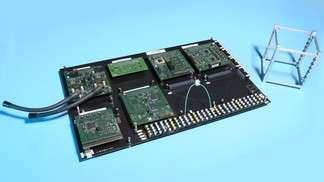The satellite's circuits and cubic structure. Credit: EPFL
(Phys.org) —CubETH is the name of a joint project between EPFL's Swiss Space Center and ETHZ whose main objective is to build a satellite scheduled for launch in late 2015. The CubETH spacecraft will be capable of calculating its own altitude and position in space with unprecedented precision thus paving the way for nano-satellite constellations with inter-satellite communication capabilities.
A second small Swiss satellite is going to be launched into space. After SwissCube in 2009, the Swiss Space Center (SSC) at EPFL is working on a new project. Baptized as CubETH, the youngest member of the Swiss cubsats family takes a lot from its predecessor: it measures ten cubic centimeters and weighs less than 1.5 kg. However, its scientific mission is more ambitious. This device is the result of a partnership with the Federal Institute of Technology at Zurich (ETHZ) as well as other collaborators. Its launching is scheduled for the end of 2015 at the earliest. The prototype is currently going through the "flat sat" stage: in order to test all its electronic components, they are electrically connected as they will be in the final structure while lying flat on a lab's table.
"We aim at making CubETH a high performance orbitographic tool capable of calculating its position, altitude and orientation in space with high accuracy," said Markus Rothacher, director of the Geodesy and Geodynamics Lab at ETH Zurich and main investigator for the scientific part of the project. The idea is to design a stable satellite in order to prevent it from spinning, as it happened to the SwissCube. "But most importantly, added the specialist, we want to create conditions for future cubsats constellations so that, for example, we could carry out thorough observations of Earth at a given time. For that reason, it is essential to know the satellites' exact orbits so as to coordinate their trajectories and scientific equipment."
Proven on Earth, unprecented in space
To achieve a more accurate measurement of the satellite's orbit, the researchers opted for GPS receivers designed by the Swiss company u-blox. "These sensors caught our interest because they are small, cheap and their performance is well proven, said Anton Ivanov, SSC researcher in charge of the satellite's entire technical design. The u-blox receivers are very common, particularly in mobile phones, but they have never been used in space. We want to prove that, by adapting its software, this low cost piece of hardware originally developed for terrestrial purposes can be used in space applications."
In addition, these sensors are compatible with other navigational systems like the Russian GLONASS or the European Galileo. Hence, researchers are envisaging using all of these GPS technologies, not only for the cubsats constellations but also in the context of the "cleaner" satellite project CleanSpace One. They could certainly provide the high precision necessary for carrying out the delicate maneuvers to approach and capture space debris.
Finally, the CubETH will also have an antenna on its side to study the atmosphere's composition and nature. The idea is yet again to verify the efficiency of less expensive components than those traditionally used in space. In such a way, the CubETH project remains faithful to the spirit behind SwissCube and cubsats in general: being a platform for testing and demonstrating the applicability of standard electronic components in space.
An educational role
The cubesats' format was devised by the California and Stanford universities to allow scholars conduct their own spatial scientific experiments at a reduced cost. The most innovative and significant design elements of SwissCube have been kept, such as the use of cell phone batteries packaged in a waterproof and thermally controlled casing. Another preserved feature is the use of the innovative system of copper pads that provide a better attachment of the solar cells on the satellite's walls.
Even before its launch, the new satellite will have also played an important educational role. In addition to generating links and collaborations between the country's two Federal Institutes of Technology, the different pieces of software on board the satellite will have been the object of study of undergraduate and doctoral students lucky enough to take advantage of a concrete project for learning about space technologies.
Provided by Ecole Polytechnique Federale de Lausanne
























